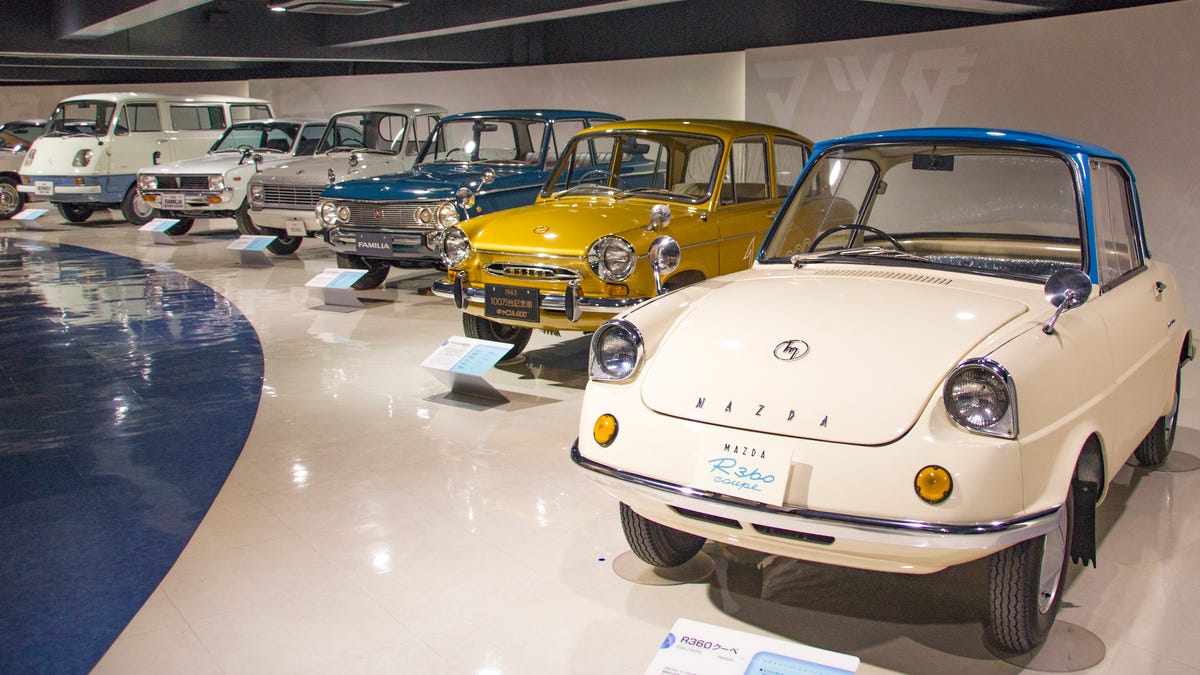 Why You Can Trust CNET
Why You Can Trust CNET RX-7, Miata and more: A tour of Mazda's factory museum
Step inside Mazda's Hiroshima factory and museum, where the company started and where it still makes many of its cars.

From the bestselling sports car of all time, to the weird and wacky Wankel, Mazda has had a long history with interesting and often unique cars. Throughout it all, its Hiroshima factory has churned out thousands of cars every year.
Today, the plant straddles a lower branch of the river Ōta, connected by one of the largest privately owned bridges in the world. Miatas and CX-5s roll off its assembly line, having been assembled from mere parts and pieces in a matter of hours.
Upstairs in one of the buildings, however, is a collection of Mazda's most famous cars. Some you certainly know, many others you might not. They're all arranged and immaculately maintained -- and, unlike most car museums, Mazda lets you walk right up and touch them.
Here's a full tour.
We begin at Mazda's corporate headquarters, a nondescript building. It's just a short walk from Mukainada station, about 30 minutes outside of downtown Hiroshima.
The lobby is festooned with the current line of Mazda vehicles, all shiny and the same shade of red. You don't stay here long, though. It's a short bus ride to the main plant, and along the way you'll cross what used to be the longest privately owned bridge in the world.
In the museum itself you're treated to a short intro to Mazda itself with a look back at 85 years of history. Then you head upstairs, where the tour starts in earnest.
It's probably not surprising that the first car you see is not Mazda's first car ever. Instead it's the Cosmo Sport: Mazda's first car to sport its beloved Wankel rotary engine, and the second car ever built with one.
The rotary is a proud part of Mazda's history, and it's a fascinating engine. It's composed of what's essentially a triangle rotating inside a pinched donut and lauded for its light weight, high horsepower, and smooth operation. But it's also derided for its low torque and high emissions.
References, examples and displays about the rotary are all over the museum, but so are Mazda's other cars. Across from the Cosmo is the Type TCS trike, Mazda's first vehicle, and its early small cars such as the R360 sit nearby, polished to a good-as-new shine.
Unlike most car museums, there are no barriers. You can go right up to the cars and peek inside -- you'll find that the interiors are just as immaculate as the exteriors.
Around the bend you'll see more modern cars such as the RX-7 and Eunos Cosmo. There's even a pristine Autozam AZ-1, known most only through its digital version in video games such as Gran Turismo.
The 787B has its own section. It's the only car from a Japanese manufacturer to win the 24 Hours of Le Mans, and the only one to win without a piston engine.
The museum finishes with a detailed look at the design and manufacturing process. From clay models to the metal stamping process to a layout of the extensive wiring under the dash of every modern car. That's seriously frightening. Like, end of "Superman III" frightening.
Then you're treated to a quick tour of the factory, where you can peer down and watch the cars being assembled. It's a fascinating sight, a blend of humans and machines. Most surprising to me was that it was a mixed assembly line, with Miatas alternating with CX-5s. Mazda claims it's more efficient, which I'm sure it is, but it's not what I expected.
Bottom line
The Mazda Museum is free, all you need to do is book ahead of time. It's a quick tour and you don't get to spend much time with the cars before you're hurried along to the next area. But it is a great look at the cars, classic and new. Zoom zoom, as they say.
As well as covering audio and display tech, Geoff does photo tours of cool museums and locations around the world, including nuclear submarines, aircraft carriers, medieval castles, epic 10,000-mile road trips and more.
Also check out Budget Travel for Dummies, his travel book, and his bestselling sci-fi novel about city-size submarines. You can follow him on Instagram and YouTube.

